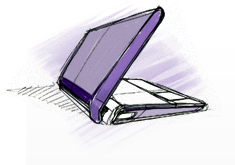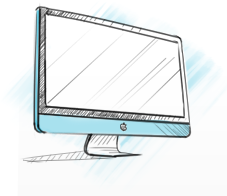Total "Gadgetization" of the population
Hello, Habr!
We have gathered such rich material here that we cannot but share it with you. Inside, there are many numbers that describe the situation with users of different gadgets!

In today's world, the number of personal electronic devices is constantly growing. In daily communication, an active person is not limited to only one device. According to a global study by Kaspersky Lab 1 , an average of 3.3 personal electronic devices with Internet access and the ability to store a large amount of information per family in Russia .
The highest indicator among the studied countries was in Saudi Arabia, where 4.3 devices are per household. The smallest number of gadgets in the house turned out to be in Romania - only 2.6 . Russia in terms of provision with devices was on the same positions as Mexico and China.
pros
 Of the modern set of personal electronic devices, the most popular in Russia is a desktop PC. Almost 66% of respondents confirmed his presence in the house. And 18.8% of respondents indicated that they have two or more desktops.
Of the modern set of personal electronic devices, the most popular in Russia is a desktop PC. Almost 66% of respondents confirmed his presence in the house. And 18.8% of respondents indicated that they have two or more desktops.
Laptops also do not lose their relevance due to the combination of high power and mobility: they are used by every second family - 53.2% . Two or more of these devices in the house have 16.2% of respondents.
The owners of “smart phones” turned out to be more than half of the respondents - 52.5% , while 24.5% of respondents reported that their families have two or more smartphones.
 As for such a newfangled gadget as a tablet PC - there are not as many as it seems! Only one in ten respondents, namely 10.7% , has already acquired it, and almost as many participants in the study ( 11.3% ) are going to acquire it in the next six months.
As for such a newfangled gadget as a tablet PC - there are not as many as it seems! Only one in ten respondents, namely 10.7% , has already acquired it, and almost as many participants in the study ( 11.3% ) are going to acquire it in the next six months.
Already in Russia, almost 6.5% of families in megacities are happy owners of a full range of modern gadgets (home PC, laptop, smartphone, tablet).
Minuses
Meanwhile, the popularity of personal electronic devices opens up more opportunities for cybercriminals. As you know firsthand, every day a user makes purchases online, communicates on social networks and chats, checks e-mail and surfing the Internet. For this, both a home PC or laptop, and a smartphone or tablet on different operating systems can be equally effectively used.
 In 2011, Kaspersky Lab experts observed an intensive growth in malware for most platforms. Thus, the Windows operating system, which dominates PC users, enjoys the same undeniable popularity among virus writers: malware for it has increased by 80% .
In 2011, Kaspersky Lab experts observed an intensive growth in malware for most platforms. Thus, the Windows operating system, which dominates PC users, enjoys the same undeniable popularity among virus writers: malware for it has increased by 80% .
Malware for Mac OS also showed a significant increase of 35% .
Among mobile operating systems, the number of malware for 4 platforms has increased the most. Closes the rating of Windows Mobile with 13% . “Bronze” gets the Symbian OS with 16% . The Java2ME environment is still a tidbit for virus writers, because most of the simplest mobile phones work on its basis. The amount of malware for it has increased by as much as 160% .
The Java2ME environment is still a tidbit for virus writers, because most of the simplest mobile phones work on its basis. The amount of malware for it has increased by as much as 160% .
But Android became the “champion” in increasing the number of malware. Believe it or not, at the beginning of 2011 there were about two dozen, and towards the end it was about 2000. This means that the increase in malware for Android amounted to almost 12,000% .
Here is such an interesting math. Of course, we did not consider all this for a reason, but in honor of the release of our new Kaspersky ONE product to protect the entire fleet of devices at once. It was thought that it was time to offer users universal protection.
Do you think anyone needs it at all or not?
1 A study of Internet users was conducted by an independent research company O + K specifically for Kaspersky Lab in 20 countries in several stages during 2011. The last wave of the survey took place in October 2011, more than 7,000 users were surveyed.
We have gathered such rich material here that we cannot but share it with you. Inside, there are many numbers that describe the situation with users of different gadgets!

In today's world, the number of personal electronic devices is constantly growing. In daily communication, an active person is not limited to only one device. According to a global study by Kaspersky Lab 1 , an average of 3.3 personal electronic devices with Internet access and the ability to store a large amount of information per family in Russia .

The highest indicator among the studied countries was in Saudi Arabia, where 4.3 devices are per household. The smallest number of gadgets in the house turned out to be in Romania - only 2.6 . Russia in terms of provision with devices was on the same positions as Mexico and China.
pros
 Of the modern set of personal electronic devices, the most popular in Russia is a desktop PC. Almost 66% of respondents confirmed his presence in the house. And 18.8% of respondents indicated that they have two or more desktops.
Of the modern set of personal electronic devices, the most popular in Russia is a desktop PC. Almost 66% of respondents confirmed his presence in the house. And 18.8% of respondents indicated that they have two or more desktops. Laptops also do not lose their relevance due to the combination of high power and mobility: they are used by every second family - 53.2% . Two or more of these devices in the house have 16.2% of respondents.
The owners of “smart phones” turned out to be more than half of the respondents - 52.5% , while 24.5% of respondents reported that their families have two or more smartphones.
 As for such a newfangled gadget as a tablet PC - there are not as many as it seems! Only one in ten respondents, namely 10.7% , has already acquired it, and almost as many participants in the study ( 11.3% ) are going to acquire it in the next six months.
As for such a newfangled gadget as a tablet PC - there are not as many as it seems! Only one in ten respondents, namely 10.7% , has already acquired it, and almost as many participants in the study ( 11.3% ) are going to acquire it in the next six months. Already in Russia, almost 6.5% of families in megacities are happy owners of a full range of modern gadgets (home PC, laptop, smartphone, tablet).
Minuses
Meanwhile, the popularity of personal electronic devices opens up more opportunities for cybercriminals. As you know firsthand, every day a user makes purchases online, communicates on social networks and chats, checks e-mail and surfing the Internet. For this, both a home PC or laptop, and a smartphone or tablet on different operating systems can be equally effectively used.
 In 2011, Kaspersky Lab experts observed an intensive growth in malware for most platforms. Thus, the Windows operating system, which dominates PC users, enjoys the same undeniable popularity among virus writers: malware for it has increased by 80% .
In 2011, Kaspersky Lab experts observed an intensive growth in malware for most platforms. Thus, the Windows operating system, which dominates PC users, enjoys the same undeniable popularity among virus writers: malware for it has increased by 80% . Malware for Mac OS also showed a significant increase of 35% .
Among mobile operating systems, the number of malware for 4 platforms has increased the most. Closes the rating of Windows Mobile with 13% . “Bronze” gets the Symbian OS with 16% .
 The Java2ME environment is still a tidbit for virus writers, because most of the simplest mobile phones work on its basis. The amount of malware for it has increased by as much as 160% .
The Java2ME environment is still a tidbit for virus writers, because most of the simplest mobile phones work on its basis. The amount of malware for it has increased by as much as 160% . But Android became the “champion” in increasing the number of malware. Believe it or not, at the beginning of 2011 there were about two dozen, and towards the end it was about 2000. This means that the increase in malware for Android amounted to almost 12,000% .
Here is such an interesting math. Of course, we did not consider all this for a reason, but in honor of the release of our new Kaspersky ONE product to protect the entire fleet of devices at once. It was thought that it was time to offer users universal protection.
Do you think anyone needs it at all or not?
1 A study of Internet users was conducted by an independent research company O + K specifically for Kaspersky Lab in 20 countries in several stages during 2011. The last wave of the survey took place in October 2011, more than 7,000 users were surveyed.
